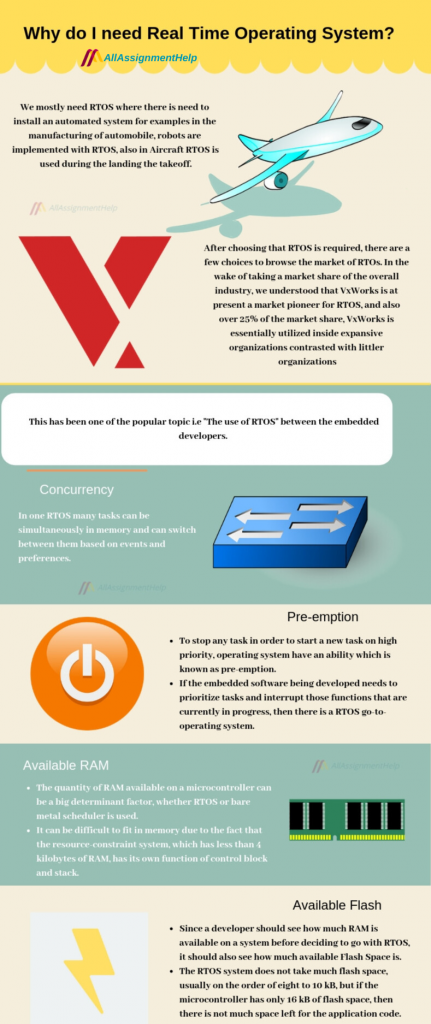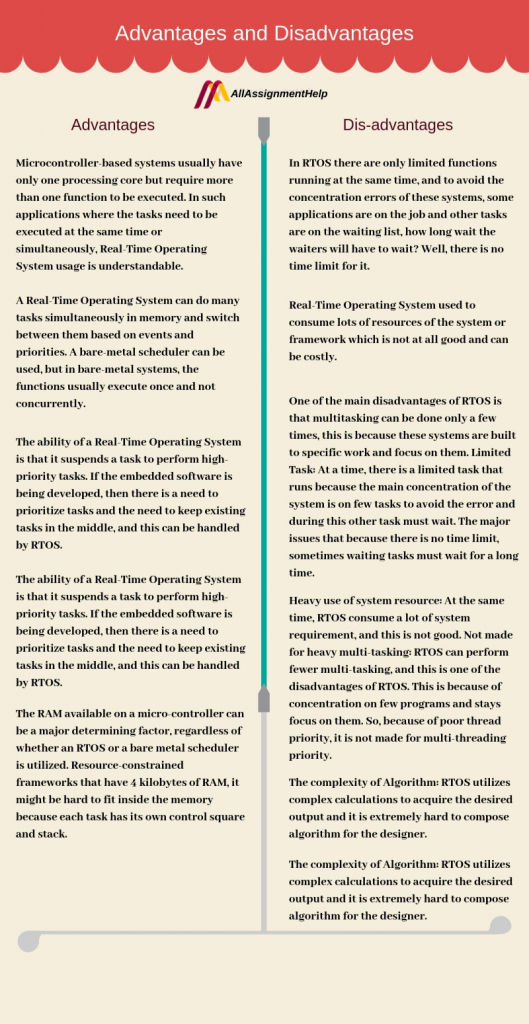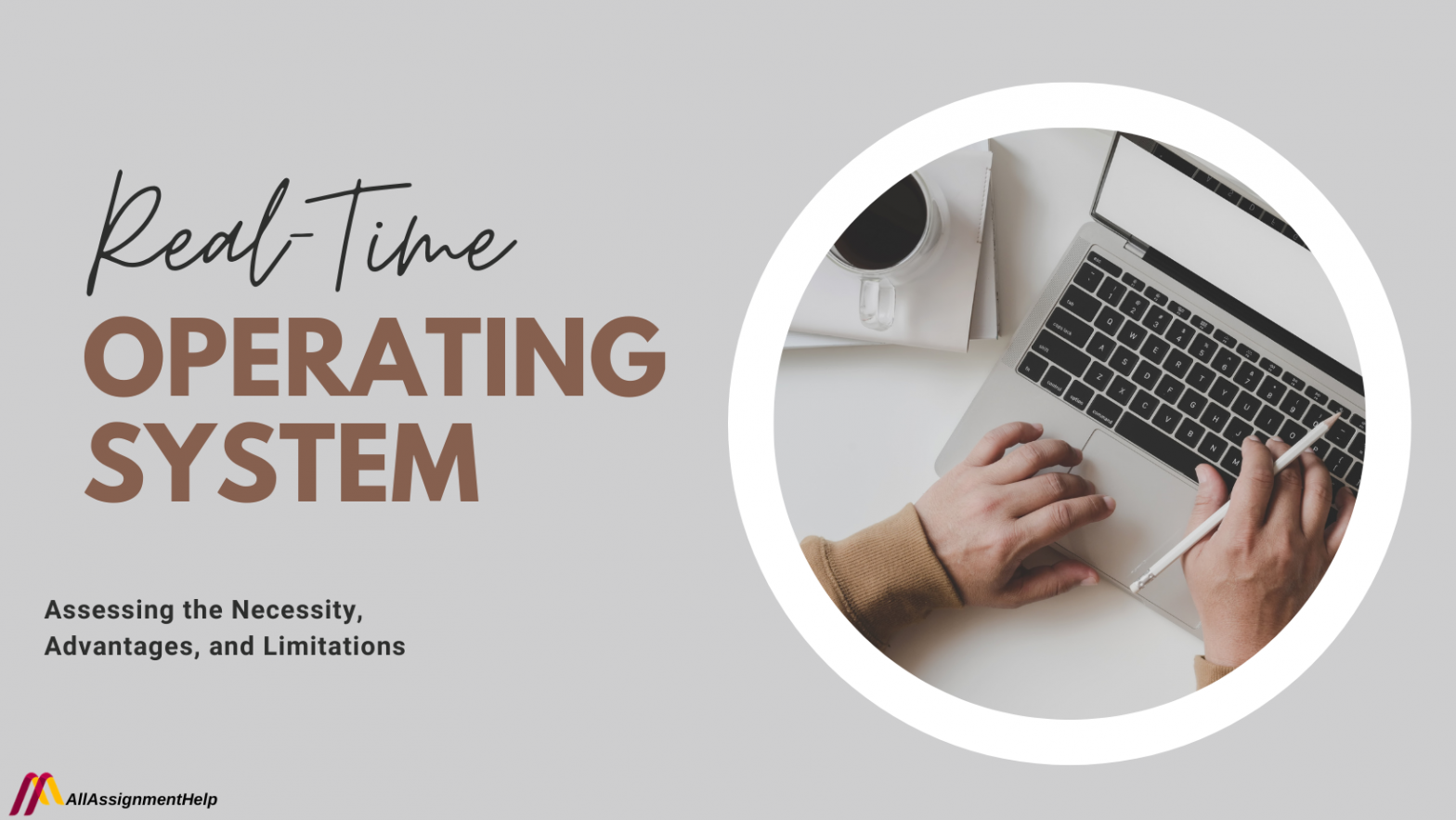Table of Contents
In today’s paced and interconnected business world, industrial sectors are constantly searching for ways to gain a competitive advantage. One of the strategies they have adopted is the integration of Real-Time Operations Systems (RTOS) into their daily operations. RTOS is not simply a term; it is a game-changing approach that empowers organizations to make split-second decisions optimize processes and improve efficiency.
Imagine a scenario where data seamlessly flows through a network of sensors, devices and applications providing real-time insights and control over every aspect of an operation. This is the potential offered by Real Time Operations Systems.
In a world where even milliseconds can determine the success or failure of a business venture Real Time Operations Systems have become more, than a feature; they have become an essential requirement. Read this blog by Allassignmenthelp and dive into the world of Real Time Operating Systems (RTOS) discovering how they are revolutionizing industries streamlining operations and fostering creativity in our constantly changing digital world.
What is an RTOS, or real-time operating system?
An operating system (OS) that assures real-time applications a certain capability within a given time frame is known as an “RTOS.” RTOSes were developed for timing-sensitive devices like microcontrollers and crucial systems. The amount of processing time needed by the RTOS is specified in milliseconds. Any pause in action could have disastrous results.
Similar to general-purpose operating systems (GPOSes) like Linux, Windows, or macOS, real-time operating systems do similar tasks, but are built with a scheduler that can adhere to strict deadlines for certain operations.
RTOS is designed to handle multiple processes at one time, ensuring that these processes respond to events within a predictable time limit. An RTOS maintains task priority while processing takes place under set time limitations. The task priority can also be modified by an RTOS.
Real-time operating systems can be designed for a variety of purposes; some are more specialized than others. Generally, RTOS offer the following features:
While some real-time operating systems are more general-purpose, others were developed for specialized uses. RTOS often offer the following features:
- Multitasking, which involves switching between tasks quickly to create the appearance that several programs are running at once;
- Priority of process threads; and
- An adequate quantity of interrupt levels.
The following devices use RTOSes:
Air traffic control systems, airbags and anti-lock brakes, cameras, medical equipment, and PCs.
Read More: Master C-Sharp and Sequel Programming Languages
Features of a real-time operating system
The following are common characteristics of real-time operating systems:

- Tiny footprint: Real-time operating systems are lightweight when compared to regular OSes.
- Superior performance: The majority of RTOSes are quick and responsive.
- Determinism: Similar output results from similar input.
- Security and protection: Standards that are essential to safety and security are usually given top consideration because RTOSes are regularly utilized in crucial systems.
- Schedule that takes priority: High-priority tasks are completed first, then those with lower priorities.
- Details about timing: Timing and application programming interfaces are handled by RTOSes.
Computer operations are very time-consuming and drawn-out, thus speeding them up enables the same kinds of batches to run collectively. The batch of users and operating systems do not communicate directly. The operating system in question does not directly communicate with the computer. The operator must group jobs with similar requirements together. If you don’t have the necessary knowledge, you can get programming assignment help from an online expert. These professionals will give you a good idea about these operation systems and how they work. They can improve your understanding of the subject.
How is an RTOS put to use?
Soft and hard real-time systems are categories of RTOSes. A hard RTOS is intended to deliver reliable reaction times within tens of milliseconds, while a soft RTOS is intended to operate within a few hundred milliseconds.
Compared to hard RTOSes, soft real-time systems often have greater file sizes. During times of high demand, some executions behave less predictably, but this is acceptable because computations are rolled back to earlier checkpoints if an error occurs. Soft RTOSes are typically employed in systems like PCs, cameras, and cell phones where time-based executions are not as crucial.
Small to medium-sized data files are standard for hard RTOSes. They behave reliably during periods of high load, and if an error happens, computation is rolled back. Hard RTOSes are typically employed in devices like autopilots, aeroplane sensors, and medical equipment that need critical time-based executions.
If the calculation required to make an object available at the specified time cannot be completed, the OS in hard real-time OSes ends with a failure. In a soft RTOS, the OS still runs, but if some tasks aren’t completed by a specific time, they can be ineffective.
Read More: Logic Programming: What are its Techniques
Comparison between Real-Time Operating Systems and General Purpose Operating Systems
Sometimes, when we think of “operating systems,” we picture things like Windows, macOS, and Linux. These serve as examples of GPOS, or general-purpose operating systems. Most of the time, these operating systems provide some sort of interface, whether it be a command line interface (CLI) or graphical user interface (GUI), and are created with user interaction. Along with offering various advantages like resource/file management and device drivers, they are also built to handle many applications, usually with multi-threading.
Multi-threaded Application vs. Super Loop
The super loop design, commonly referred to as “bare-metal programming,” is likely something you are already familiar with if you have previously created an embedded application. In this case, there is no operating system, and the layout is very straightforward: in your main method, you set up any variables, drivers, libraries, etc. before carrying out one or more recurring activities in a while(true) loop. This is represented in the Arduino library by the setup() and loop() routines (which are merely functions called from main()).
The super loop application is flawless. In the real world, since it’s simple to build and simple to debug, it’s still among the most popular methods for programming microcontrollers. Using interrupt service routines (ISRs), which allow the application to shut down and run some arbitrary code when an external event takes place, you may even add interruptions.
If there are numerous tasks to complete during the main loop, they are often carried out in a round-robin method. The issue arises when you start adding so many tasks that several begin missing due dates or impairing the functionality of other features. An RTOS can be useful in this situation.
Things should be considered while Choosing Real-time operation systems
The following elements should be taken into account while looking for an RTOS:
- Responsiveness. The scheduling method, interrupt latency, and context switch times are aspects that affect responsiveness.
- Certificates for safety. Pre-certified and certified RTOSes guarantee that the RTOS quality complies with accepted design criteria.
- System resources that are available. The kind of system resources required are specified by the architecture. Microkernels, for instance, make minimal use of system resources.
- Security. Both paid RTOSes and free, open-source alternatives are accessible. Both have built-in security protections, while some have more functions available.
- Support for more recent versions. Incorporating long-term use is also important. If a company intends to utilize the RTOS for a considerable amount of time, future support and updates should be taken into account.
There are countless courses available online that can help you advance your knowledge about OS and IOS. There is a solution if you are thinking about enrolling in online coursework but are unclear about how to manage everything at once. In difficult circumstances, you might hire someone to do your online class so you can get beyond the difficulties of maintaining a healthy balance between your work and study.
Popular RTOS Applications And Criteria for Selecting An OS
The following are examples of well-known open-source and paid RTOS software products:
- Provided by Amazon Web Services is FreeRTOS. This free and open-source microcontroller operating system is made to make it easier to develop, secure, deploy, and maintain microcontroller edge devices.
- BlackBerry QNX Neutrino. This commercial real-time operating system is made for embedded computers and is similar to Unix. One of the first microkernel OSes to be successful commercially is this one.
- Wind River’s VxWorks. This RTOS facilitates the deployment of applications inside containers. VxWorks is the software used by Mars Exploration Rovers.
- Wittenstein’s SafeRTOS. This embedded processor-specific safety real-time operating system has already received certification.
These are a few well-liked RTOS programs that are widely used. Some of these may be new to you. We know of these facts because a number of learners who seek help with database management assignments also lack a solid understanding of the terms OS, IoS, and other programming languages. Once they hire a professional they know everything in detail as these programming professionals are so talented and equipped with good knowledge of technology and systems. When they interact with a professional, they are able to understand everything in detail because these programmers are so talented and well-versed in systems and technology.
Real-Time Operating Systems: Assessing the Necessity, Advantages, and Limitations
Well, we already know a lot about RTOS and its characteristics. If you still want to know more then refer to the infographic below to learn more about the requirements and to evaluate the benefits and drawbacks of these operating systems:

Scroll down 

I hope this blog post has answered all the questions you had before reading it. Stay connected with us for more information like this because we always have some intriguing topics to discuss.
Read More: Online Education: The Most Effective Way to Learn New Skills
FAQs
| Ques.1. What skills are required to complete a programming assignment? One of the most crucial problem-solving abilities you should have when working on programming tasks is the capacity for effective research. You must conduct extensive background research on the topic of the assignment in order to successfully complete a programming-based question. |
| Ques.2. Why do businesses require database management systems? To maintain large databases, organizations need reliable, secure, and user-friendly technologies. |
